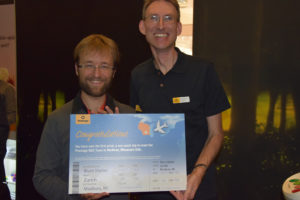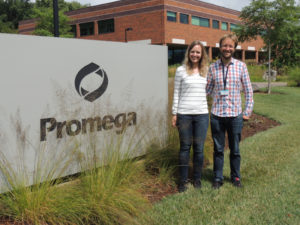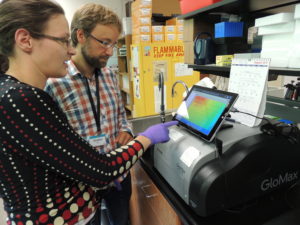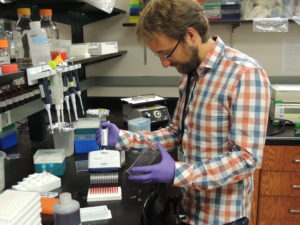
Walter Blum knew how normal cells worked. He had studied and read about the pathways that regulated cell cycles, growth and development; he saw the cell as an amazingly well programmed, intricate machine. What he wanted to understand was: “Why does a cell become crazy? How does it escape immune system surveillance?”
Last week I had the opportunity to sit down with Dr. Blum, a customer of our Promega Switzerland branch. Dr. Blum won a trip to visit our campus in Madison for a week as part of an anniversary celebration for our Switzerland branch. While here, he got an inside peek at research and manufacturing operations, chatted with our scientists, met with our marketing teams and saw the sights in Madison. We talked about his work and what he learned and is taking back with him from his trip to Madison.
When Dr. Blum began his Masters thesis work on malignant mesothelioma, he encountered Promega products almost immediately, becoming familiar with genomics products for DNA and RNA isolation, cloning and our GoTaq® line, and Promega has continued to assist him as his research questions have evolved.
What he wanted to understand was: “Why does a cell become crazy? How does it escape immune system surveillance?”
Mesothelioma is an aggressive form of cancer that occurs in the thin layer of tissue that covers most of our internal organs (the mesothelium). Most commonly, when we think mesothelioma, we think of the mesothelium of the lungs (the pleura), and mesothelioma caused by the inhalation of asbestos fibers. Blum is interested in understanding how this cancer develops—what events happen and in what order before the cells can escape the toxicity of asbestos (and die) to become malignant instead.

Dr. Blum’s work first focused on gene expression and regulation, in particular the involvement of the SV40 virus as a cofactor in the development of mesothelioma. In the course of his research, he was performing traditional genomic experiments like DNA and RNA purification, cloning and subcloning and PCR amplification.
Asbestos exposure can be toxic to cells, causing them to die. However sometimes, cells exposed to asbestos fibers don’t die; they escape the toxicity, suggesting that other factors (such as the expression SV40 genes or a particular genetic background) must also be present before cancer develops.
 As his research questions changed from looking at gene expression to cellular responses, specifically assessing apoptosis, Dr. Blum became familiar with Promega cell-based assay products such as the Caspase-Glo® Assays, which he used to determine which cell death pathways were being activated or suppressed in response to the expression of specific proteins. Seeing what is happening in individual cells is critical to understanding the molecular mechanisms behind malignant mesothelioma, but looking at what happens in the entire animal is important too. Dr. Blum’s work also included following tumor progression in live animals, and for this work, luciferase reporters and an in vivo luciferin substrate from Promega were critical to understanding what happens to tumors in animal in response to treatment or other environmental factors.
As his research questions changed from looking at gene expression to cellular responses, specifically assessing apoptosis, Dr. Blum became familiar with Promega cell-based assay products such as the Caspase-Glo® Assays, which he used to determine which cell death pathways were being activated or suppressed in response to the expression of specific proteins. Seeing what is happening in individual cells is critical to understanding the molecular mechanisms behind malignant mesothelioma, but looking at what happens in the entire animal is important too. Dr. Blum’s work also included following tumor progression in live animals, and for this work, luciferase reporters and an in vivo luciferin substrate from Promega were critical to understanding what happens to tumors in animal in response to treatment or other environmental factors.
The timing of Dr. Blum’s visit to Madison coincides with the end of a fellowship for him. Just as research evolves and changes, scientific careers do as well. Dr. Blum is at a point of decision in his own career, and his visit to Promega gave him the opportunity to meet with scientists pursuing scientific research, technology development and supporting research in a variety of careers.
 Currently his research requires higher throughput genomics, isolating DNA and RNA from patient samples, and he has turned again to Promega products as he looks at genomics on this slightly larger scale, using the Maxwell® instrument and chemistries for his work. Real-time PCR assays and next-generation sequencing are on the horizon for gaining a systems level view of what is happening inside affected cells—a long way from the initial studies of single genes and single proteins.
Currently his research requires higher throughput genomics, isolating DNA and RNA from patient samples, and he has turned again to Promega products as he looks at genomics on this slightly larger scale, using the Maxwell® instrument and chemistries for his work. Real-time PCR assays and next-generation sequencing are on the horizon for gaining a systems level view of what is happening inside affected cells—a long way from the initial studies of single genes and single proteins.
“This trip to Promega, the experience I get in this week, is something money cannot buy,” according to Blum. It will inform his career decision. It will inform the direction he takes his research as well.
When I asked him what surprised him most about Promega this week, he indicated that it was the fact that the same team spirit that exists among the branch members at Promega Switzerland, with whom he usually interacts, is found at the Promega headquarters, too. He wasn’t sure that the same caring and friendly attitudes would carry over from the smaller branch office to the larger headquarters, but they did.
“This trip to Promega, the experience I get in this week, is something money cannot buy.”
Referring to the third spaces, the Promega guest house, and the Feynman winter garden, Blum said, “I’m also impressed by the way Promega cares for its employees. It provides spots that look like home—it’s not sterile, it has the look of life.”
Thank you Walter! We are glad you enjoyed your time here at Promega; we enjoyed hosting you.
Michele Arduengo
Latest posts by Michele Arduengo (see all)
- IL-6/STAT3-Regulated Long Non-Coding RNA Is Involved in Colorectal Cancer Progression - July 1, 2025
- Using Dual-Luciferase Assays to Identify the Role of Non-Coding RNAs in Disease - May 2, 2025
- An Unexpected Role for RNA Methylation in Mitosis Leads to New Understanding of Neurodevelopmental Disorders - March 27, 2025
